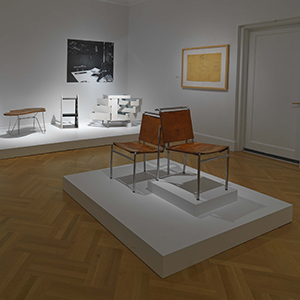THE EXHIBITION
Born Kathleen Eileen Moray Smith-Gray in 1878 in Ireland, the woman who came to be known simply as Eileen Gray was one of the twentieth century’s most accomplished designer-architects. Although today she is recognized as a pioneering woman in the predominantly male field of modern architecture, history largely forgot her after the Second World War until her death in 1976. When the Centre Pompidou in Paris organized the exhibition Eileen Gray in 2013, it had been almost forty years since the last display of her work. In the United States, Eileen Gray has not been the subject of an exhibition since the Museum of Modern Art organized Eileen Gray, Designer in 1980.
Bard Graduate Center’s Eileen Gray exhibition considers the scope and versatility of Eileen Gray’s practice, which includes furniture, lighting, rugs, interiors, architecture, painting, drawing, and photography. Among the distinguishing features of her long and prolific career—she continued to work until she died in 1976 at the age of ninety-eight—are the consistent quality and integrity of her practice, exemplified in the choice of materials, the investment in authentic methods of production, and the experimentation in the design process to discover inventive ways to respond to basic human needs.
The exhibition examines the various phases of Eileen Gray’s career thematically and chronologically. On the first floor, Chronology and Encounters introduces key events in her long career and presents the many artists, writers, and intellectuals who fostered Gray’s particular interpretation of modernism in design and architecture. The adjacent first floor gallery considers specific examples of Gray’s lacquer work from American collections. Different aspects of her life in Paris are featured on the second floor, including Galerie Jean Désert; her interior projects; and the impact of Jean Badovici and modern architecture on her career. The third floor examines Gray’s principal architectural works, among them E 1027 and Tempe a Pailla.
Click the links on the right to explore different views of the exhibition and then click within the installation photographs to learn about selected objects on display.
THE EXHIBITION
Born Kathleen Eileen Moray Smith-Gray in 1878 in Ireland, the woman who came to be known simply as Eileen Gray was one of the twentieth century’s most accomplished designer-architects. Although today she is recognized as a pioneering woman in the predominantly male field of modern architecture, history largely forgot her after the Second World War until her death in 1976. When the Centre Pompidou in Paris organized the exhibition Eileen Gray in 2013, it had been almost forty years since the last display of her work. In the United States, Eileen Gray has not been the subject of an exhibition since the Museum of Modern Art organized Eileen Gray, Designer in 1980.
Bard Graduate Center’s Eileen Gray exhibition considers the scope and versatility of Eileen Gray’s practice, which includes furniture, lighting, rugs, interiors, architecture, painting, drawing, and photography. Among the distinguishing features of her long and prolific career—she continued to work until she died in 1976 at the age of ninety-eight—are the consistent quality and integrity of her practice, exemplified in the choice of materials, the investment in authentic methods of production, and the experimentation in the design process to discover inventive ways to respond to basic human needs.
The exhibition examines the various phases of Eileen Gray’s career thematically and chronologically. On the first floor, Chronology and Encounters introduces key events in her long career and presents the many artists, writers, and intellectuals who fostered Gray’s particular interpretation of modernism in design and architecture. The adjacent first floor gallery considers specific examples of Gray’s lacquer work from American collections. Different aspects of her life in Paris are featured on the second floor, including Galerie Jean Désert; her interior projects; and the impact of Jean Badovici and modern architecture on her career. The third floor examines Gray’s principal architectural works, among them E 1027 and Tempe a Pailla.
Click the links below to explore different views of the exhibition and then click within the photographs below to learn about selected objects on display.
THE ART OF LACQUER
THE ART OF LACQUER


Auguste Rodin (1840–1917)
Danaïd
1885
Bronze
Collection of Maryhill Museum of Art
Eileen Gray was introduced to French sculptor Auguste Rodin through her circle of English writers and artists in Paris. Of Gray’s friends, Kathleen Bruce was one of Rodin’s students, Stephen Haweis was his photographer, and Wyndham Lewis wrote several sonnets about the sculptor. In 1902 or 1903, Gray sent the letter shown here to Rodin about a small Danaïd she had purchased from him.
In Greek mythology, the Danaïds are women who killed their husbands on their wedding nights, and whose punishment is to fill a bottomless vessel with water. Rodin depicts the Danaïd bent over, exhausted from her interminable task.
Though it is unclear exactly how this Danaïd was acquired from Rodin, the sculpture entered the collection of the Maryhill Museum of Art in 1938, which also houses the Oriental Mountebanks lacquer panel in this gallery. This Danaïd is probably similar to the one Gray owned.
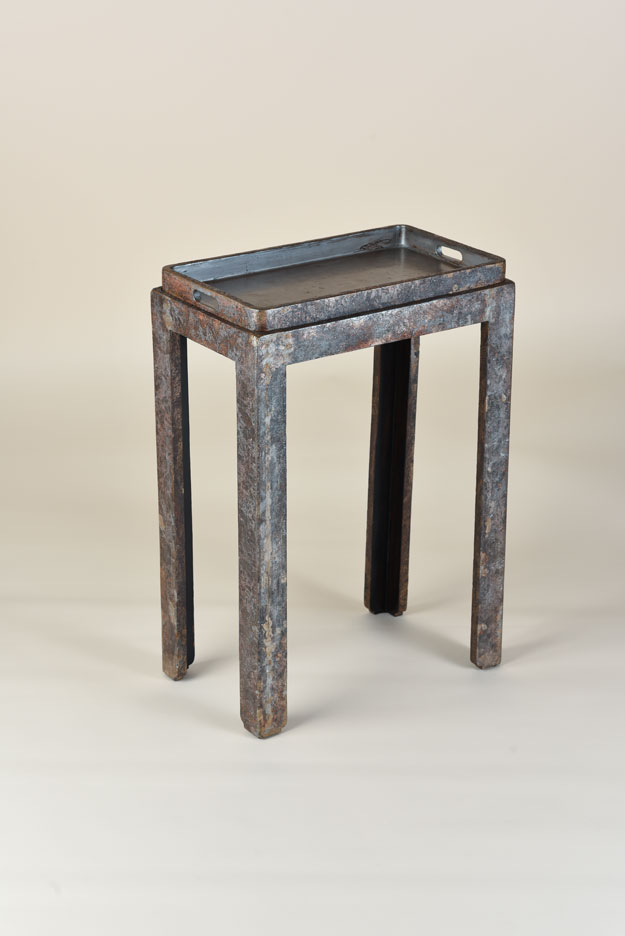
Eileen Gray (1878–1976)
Table à thé (Tea table)
Before 1926
Lacquered wood
Galerie Anne-Sophie Duval
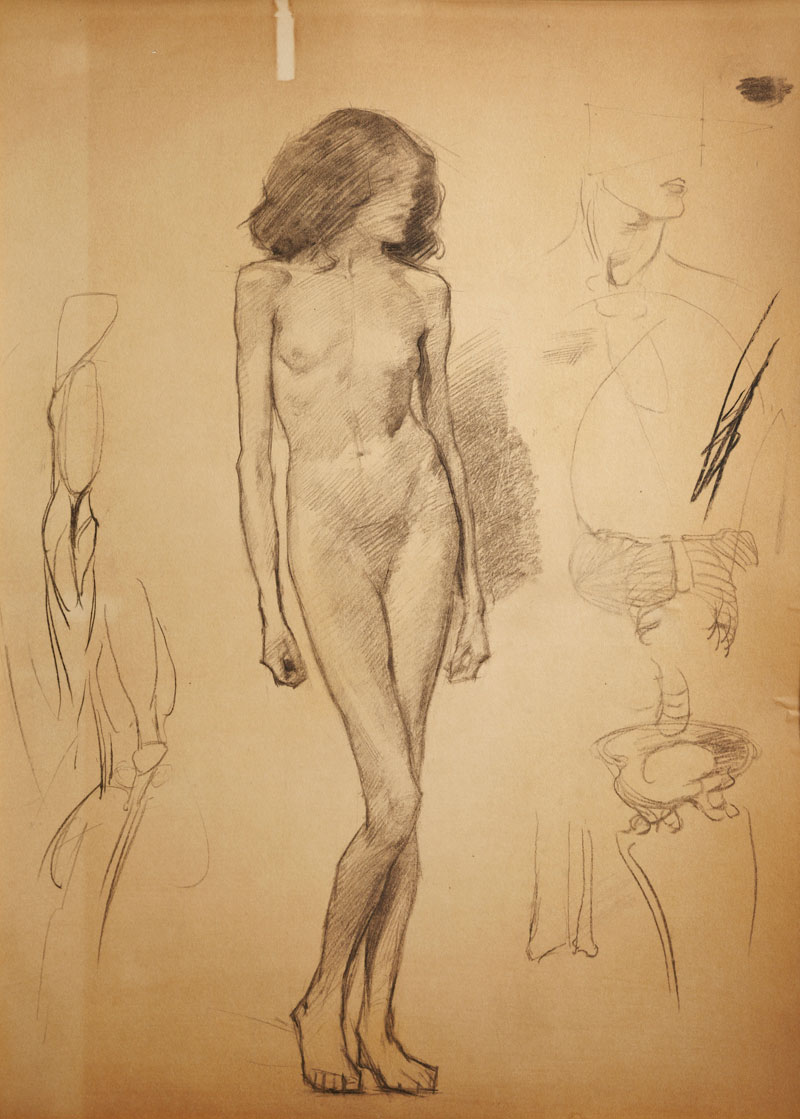
Eileen Gray (1878–1976)
Nu au fusain (Nude drawing)
1903
Charcoal on paper
National Museum of Ireland, NMIEG 2000.115
Gray enrolled in the Slade School of Fine Art in London in 1901 after visiting the 1900 Exposition Universelle with her mother in Paris. Although the school was considered advanced in that female and male students took all except life drawing classes together, Gray was ultimately dissatisfied with the instruction and would only attend classes until 1902, when she moved to Paris with several friends. Gray destroyed much of her student artwork, and this is one of the few sketches that survive from this period.

Eileen Gray (1878–1976)
Screen
ca. 1921–23
Incised wood with brown and tan lacquer
Collection of Kelly Gallery and Stephen Kelly, New York
The incised motifs on this six-panel screen mark a significant transition from the figurative compositions Gray favored in her earlier lacquer pieces. The variations in thickness of the lines bring to mind the abstract paintings Piet Mondrian created while living in Paris in the early 1920s, and they reveal how Gray’s work was informed by the Dutch avant garde. This screen was first published in 1924 in the Dutch magazine Wendingen, pictured alongside a lacquered floor lamp on display on the second floor and a lacquer Lit pirogue (canoe daybed), all made for Georgette Labourdette, wife of French car designer Jean-Henri Labourdette. Gray sold screens such as this one and other lacquer furniture at the Galerie Jean Désert, which opened in May 1922.
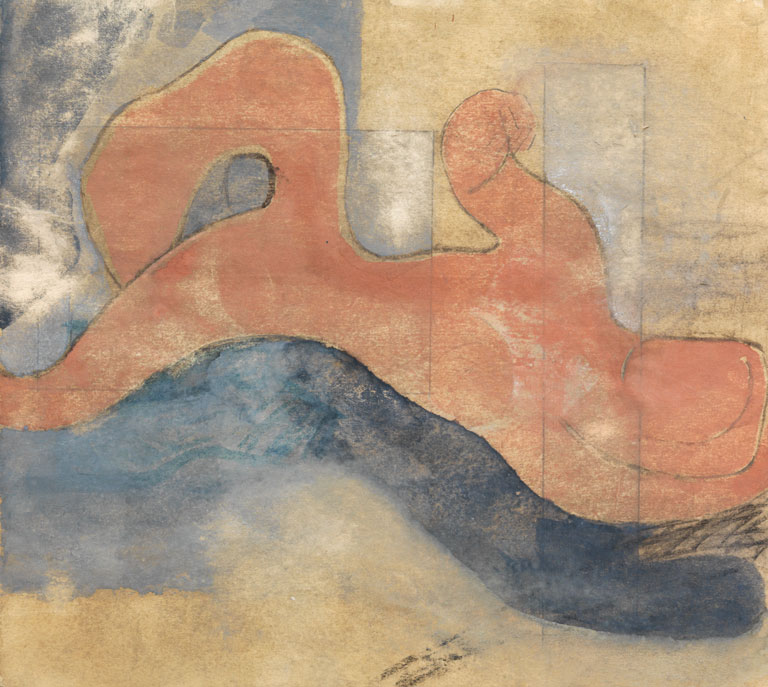
Eileen Gray (1878–1976)
Untitled
1920
Gouache, pencil, and collage on paper
Peter Adam Collection
First Floor, South Gallery
Eileen Gray first discovered lacquer around 1900, during regular visits to the Victoria and Albert Museum in London. Later, while attending the Slade School of Fine Art, she began an apprenticeship with furniture restorer Dean Charles who specialized in Chinese lacquer. After moving to Paris in 1906, Gray met Japanese craftsman Seizo Sugawara, who taught her methods of Japanese lacquer. Four years later, they opened a lacquer workshop at 11, rue Guénégaud, where they worked in collaboration for more than twenty years. Gray kept diligent notes about the lacquer recipes she learned in a notebook, where her attention to detail is evident. Her commitment to authentic methods of production, a laborious and time-consuming process, is what distinguished her work from others who produced lacquer in France during the interwar years.
The pieces on view in this gallery show the pronounced changes in Gray’s lacquer work over several decades. Oriental Mountebanks, a lacquer wall panel that exemplifies Gray’s early figural work, has not been on public view since it was shown in the French Pavilion at the 1915 Panama– Pacific International Exposition in San Francisco. Whereas many of Gray’s wall panels tell stories in lacquer, the large freestanding screen in the gallery is indicative of the abstract compositions Gray created more frequently after 1914.
Eileen Gray first discovered lacquer around 1900, during regular visits to the Victoria and Albert Museum in London. Later, while attending the Slade School of Fine Art, she began an apprenticeship with furniture restorer Dean Charles who specialized in Chinese lacquer. After moving to Paris in 1906, Gray met Japanese craftsman Seizo Sugawara, who taught her methods of Japanese lacquer. Four years later, they opened a lacquer workshop at 11, rue Guénégaud, where they worked in collaboration for more than twenty years. Gray kept diligent notes about the lacquer recipes she learned in a notebook, where her attention to detail is evident. Her commitment to authentic methods of production, a laborious and time-consuming process, is what distinguished her work from others who produced lacquer in France during the interwar years.
The pieces on view in this gallery show the pronounced changes in Gray’s lacquer work over several decades. Oriental Mountebanks, a lacquer wall panel that exemplifies Gray’s early figural work, has not been on public view since it was shown in the French Pavilion at the 1915 Panama– Pacific International Exposition in San Francisco. Whereas many of Gray’s wall panels tell stories in lacquer, the large freestanding screen in the gallery is indicative of the abstract compositions Gray created more frequently after 1914.
BEDROOM/BOUDOIR FOR MONTE CARLO
BEDROOM/BOUDOIR FOR MONTE CARLO


Eileen Gray (1878–1976)
Screen for Chambre à coucher boudoir pour Monte-Carlo (Bedroom/Boudoir for Monte Carlo)
1923
Wood, white paint
National Museum of Ireland, NMIEG 2000.10
Folded photos: Bruce White
Two white brick screens appear in the large photograph of the 1923 Salon installation shown here. The concept of the brick screen developed from an idea Gray first implemented in the hallway of Juliette Lévy’s rue de Lota apartment in 1919, where she utilized a series of movable rectangular forms to cover existing moldings and to provide a visual break in the length of the hall. Although the Lévy hallway featured lacquer “bricks,” and Gray would make several lacquer versions of this design, this example is painted wood. Gray returned to this form throughout her career. When the screen is completely folded, as shown in the photograph here, it retains the qualities of a freestanding sculptural form. The subtle layering and juxtapositions of the panels could only have been conceived through mathematical calculation and precision.

Eileen Gray (1878–1976)
Guéridon (Pedestal table)
1922–25
Oak and lacquer
Kravis Collection
Photo: Arnaud Carpentier
Gray’s understanding of various lacquer techniques is evident in this design. The smooth top in black lacquer contrasts with the curving legs of the table, where Gray likely used sabi coromandel, a combination of plaster, rabbit-skin glue, and lacquer, which results in a rough, textured surface.

Eileen Gray (1878–1976)
Table-coiffeuse (Dressing table)
ca. 1920
Stained oak and white sycamore, glass top
Private collection, courtesy Galerie Vallois, Paris
Photo: Arnaud Carpentier
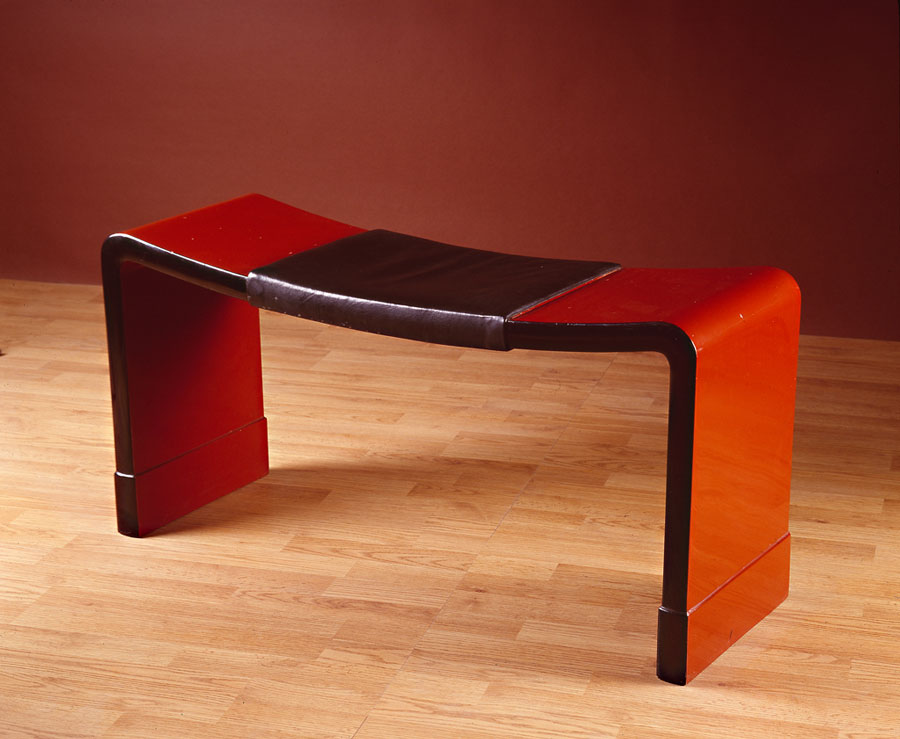
Eileen Gray (1878–1976)
Banquette (Bench)
1920–22
Wood, lacquer, leather
Kravis Collection
Photo: Arnaud Carpentier

Eileen Gray (1878–1976)
"Lanterne Japonaise" lamp
ca. 1935
Painted steel, Perspex, mirrored glass globe
The Metropolitan Museum of Art, Gift of Seymour Stein, 1984, 1984.564.2a,b
Photo: © The Metropolitan Museum of Art. Image source: Art Resource, NY.

Eileen Gray (1878–1976)
“Rocket” floor lamp
1923
Lacquer, wood, painted parchment shade (modern replacement), electrical parts
Virginia Museum of Fine Arts, Richmond, Gift of Sydney and Frances Lewis, 85.169a-c
Photo: Katherine Wetzel
There is evidence that Gray made three versions of this “Rocket” floor lamp. This example was shown in 1923 and was later acquired by Juliette Lévy. It is known that Georgette Labourdette, one of Gray’s most devoted clients, purchased an example of this lamp, and a third version was in the collection of the actress Damia, who was a friend of Gray’s during the 1920s.
The lampshade was replaced in the 1970s by the Virginia Museum of Fine Arts with assistance from Gray’s niece, Prunella Clough, and surviving drawings of Gray’s original design.

Chambre à coucher boudoir pour Monte-Carlo, exhibited at the Salon de Société des Artistes Décorateurs, Paris, 1923. Archives Gilles Peyroulet, Paris.
Second Floor, North Gallery
Eileen Gray designed a small number of interiors for clients and exhibitions during the 1920s. In 1923, she presented Chambre à coucher boudoir pour Monte-Carlo (Bedroom/Boudoir for Monte Carlo), an ambitious and controversial installation, at the 14th annual Salon de la Societé des Artistes Décorateurs in the Grand Palais in Paris, an important venue for designers to show new work. She created the interior and all of the furnishings, which included two white “block” screens, a lacquer desk, a banquette (bench), rugs, lamps, wall hangings, and a small table. Gray drew inspiration for the unusual design from contemporaneous theater productions. Spatially, she created a plan that surprised visitors by disrupting the conventional alignment of the room and by installing horizontal platforms at different angles, much like a stage set. She lined the floor with a shiny material that captured the reflection of the outside walls and the freestanding screens. She used mirrors to enhance the sensory experience of the main room and to give the impression of a space larger than it was in reality.
The installation drew largely negative reviews from French critics. However, architect Jean Badovici, with whom Gray would maintain a long-term personal and working relationship, praised her design in an article in L’Architecture Vivante and in the Dutch magazine Wendingen, noting that Gray’s treatment of the space and furnishings generated a sense of calm and “internal fulfillment.”
Eileen Gray designed a small number of interiors for clients and exhibitions during the 1920s. In 1923, she presented Chambre à coucher boudoir pour Monte-Carlo (Bedroom/Boudoir for Monte Carlo), an ambitious and controversial installation, at the 14th annual Salon de la Societé des Artistes Décorateurs in the Grand Palais in Paris, an important venue for designers to show new work. She created the interior and all of the furnishings, which included two white “block” screens, a lacquer desk, a banquette (bench), rugs, lamps, wall hangings, and a small table. Gray drew inspiration for the unusual design from contemporaneous theater productions. Spatially, she created a plan that surprised visitors by disrupting the conventional alignment of the room and by installing horizontal platforms at different angles, much like a stage set. She lined the floor with a shiny material that captured the reflection of the outside walls and the freestanding screens. She used mirrors to enhance the sensory experience of the main room and to give the impression of a space larger than it was in reality.
The installation drew largely negative reviews from French critics. However, architect Jean Badovici, with whom Gray would maintain a long-term personal and working relationship, praised her design in an article in L’Architecture Vivante and in the Dutch magazine Wendingen, noting that Gray’s treatment of the space and furnishings generated a sense of calm and “internal fulfillment.”
E 1027
E 1027


Eileen Gray (1878–1976)
Coiffeuse aluminium et liège (Dressing cabinet in aluminum and cork)
1926–29
Painted wood, aluminum sheets, cork, aluminum leaf
Centre Pompidou, Musée national d’art moderne, Paris, Purchase, 1992, AM 1992-1-6
Gray’s Coiffeuse aluminium et liège (or Coiffeuse-screen) was created in three different versions between 1926 and 1932; the first for the main bedroom of E 1027 (on view in this gallery), the second for Tempe a Pailla, and the third for Jean Badovici’s studio apartment at 17, rue in Paris. It joins the trajectory of screens and partitions that are so important in Gray’s work, most of them used primarily to divide space. The three versions of the cabinet, although of similar dimensions, are each constructed differently and play with the open space of the shelves and the solid surface of the drawers, using a variety of materials and finishes that depend on which space Gray chose to put them.

Eileen Gray (1878–1976)
Chaise de salle à manger (Dining room chair)
1926–29
Nickel-plated steel, brown leather
Centre Pompidou, Musée national d’art moderne, Paris, Gift of the Société des Amis du Musée national d’art moderne, 2011, AM 2011-1-35
Photo: Bertrand Prévost
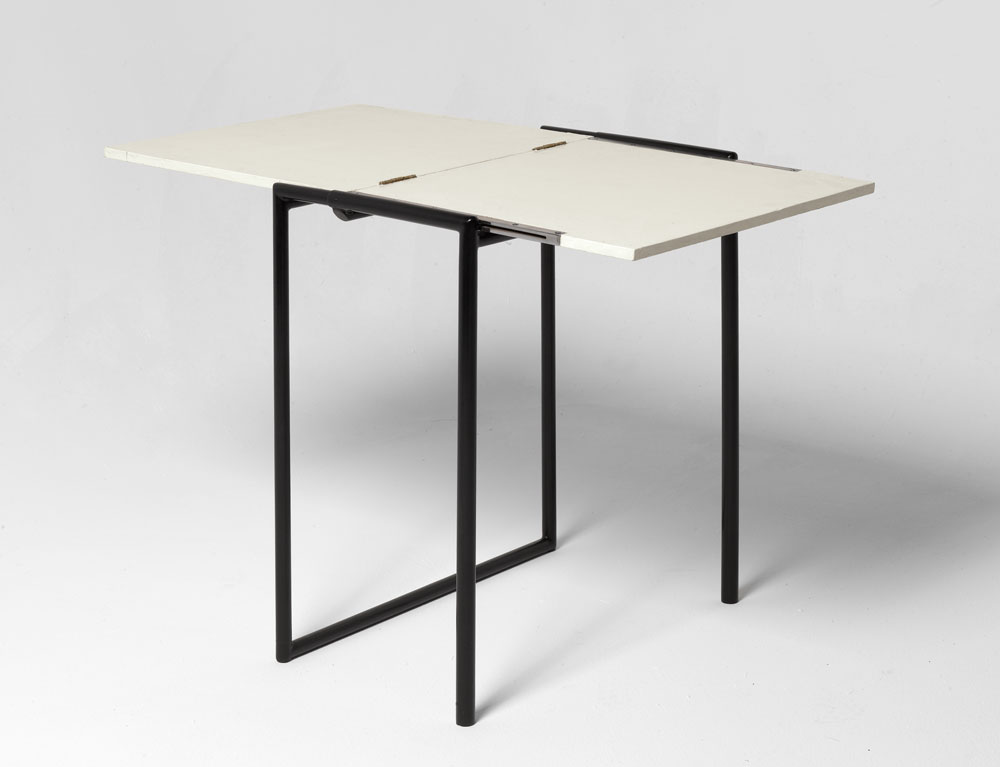
Eileen Gray (1878–1976)
Table-élément (Element table)
1926–29
Lacquered tubular steel, wood
Centre Pompidou, Musée national d’art moderne, Paris, Purchase, 1992, AM 1992-1-5
Gray used the Table-élément in several rooms in E 1027. This table serves many purposes: a desk, a dining table, and a side table. As a dining table, it can be used alone for one or two people or combined to seat several diners. Gray not only created a design that joins individual pieces together, but she also focused attention on the table top, which slides and unfolds, doubling its length. In the spirit of camping furniture, the table is light enough to be moved easily from room to room, and adapts to different purposes and spaces.

Eileen Gray (1878–1976)
Coiffeuse transportable (Mobile dressing table)
1926–29
Tubular metal, wood, leather, glass (restored in 2018)
Musée des Arts Décoratifs, Paris, 2019.130.1
Gift of the Rebutato family
Photo: © MAD, Paris / Christophe Dellière

Eileen Gray (1878–1976)
Petite table d’appoint (Small side table)
ca. 1926-29
Painted wood
Collection Jacques De Vos, Paris
Photo: Studio SLB-CH BARAJA

Eileen Gray (1878–1976)
Fauteuil transat (Transat armchair)
1926–29
Varnished sycamore, nickel-plated steel, synthetic leather
Centre Pompidou, Musée national d’art moderne, Paris, Purchase, 1992, AM 1992-1-1
Like Gray’s other Transat chairs, the version she designed for E 1027 is adapted to the space. It can be placed in the living room or on the terrace, because the black-coated canvas upholstery is designed to resist damage from the salt air of the Mediterranean and the rain.

Eileen Gray (1878–1976)
Meuble à linge de la douche (Shower room linen cabinet)
1926–29
Painted wood
Collection Jacques De Vos, Paris
Photo: Studio SLB-CH BARAJA
Like the small black and white table, Gray’s linen cabinet is a clear homage to Dutch De Stijl. Gray had visited Gerrit Rietveld’s Schröder House in Utrecht in 1925 with Jean Badovici. Inspired by its northeast façade, Gray’s linen cabinet stands upright and echoes an architectural form. Emphasizing the relationships between open spaces and solid surfaces, Gray divided the piece into two contrasting parts: the left side is open at the front, and the right side conceals storage compartments on the top and bottom. She chose to paint the wood white on the exterior and brown on the interior, thereby heightening the effects of light and shadow on the individual parts. Gray would adopt the same system of holes allowing air circulation in the design for her Siège-escabeau-porte-serviettes (Seat-stepstool-towel rack).

Eileen Gray (1878–1976)
Table à desservir de la salle à manger (Dining room serving table)
1926–29
Painted wood
Centre Pompidou, Musée national d’art moderne, Paris, Purchase, 1992, AM 1992-1-4
An iconic piece designed by Eileen Gray for E 1027, this table, often called Cabinet à tiroirs pivotantes (Cabinet with pivoting drawers), was directly inspired by Vorticism, the movement founded in 1914 by Wyndham Lewis, one of Gray’s close friends and a classmate at both the Slade School of Fine Art in London and the Académie Julian in Paris. This small storage cabinet, intended for the living room, is doubly inventive: placed against one of the posts built into the wall that divides a row of bay windows, it occupies and separates space; at the same time, the back hides a set of four hidden drawers that only appear when they pivot open, increasing the visual dynamism of the form. The contrast between the sliding and pivoting drawers, which join inside the piece, recalls the geometric patterns in Lewis’s paintings.

Eileen Gray (1878–1976)
Table pour petit déjeuner (Breakfast table)
1927
Lacquered tubular steel, cellulose acetate
Centre Pompidou, Musée national d’art moderne, Paris, Purchase, 1992, AM 1992-1-3
Eileen Gray designed this small breakfast table, also known as the Table E 1027 or Adjustable table, for E 1027. Its adjustable height and form make it useful for different purposes. It can be raised and lowered much like a slide trombone, and its design is light, mobile, and adaptable. The tubular steel frame features an offset base, which allows it to slide underneath a bed, for example. Photographs of E 1027 from 1929 show the table in use in the guest bedroom, with the base hidden underneath the bed frame, for eating in bed, and also turned in the opposite direction, ready to be carried by its handle to another part of the house. Although several different versions of the design were made, using either celluloid or aluminum for the table top, few from the era remain. The version on display was originally in E 1027, but it has been repainted several times, and at some point its celluloid top may have been replaced.

Eileen Gray (1878–1976)
Fauteuil non conformiste (Nonconformist armchair)
1926–29
Painted tubular steel, painted wood
Collection Gilles Peyroulet, Paris
Gray’s Fauteuil non conformiste is a one-of-a-kind, experimental chair-armchair designed for E 1027 and placed in its living room. The unusual form with only one armrest allows greater freedom of movement. According to Gray, the design makes it possible for one to cross one’s legs and lean an elbow on the armrest to smoke while turning slightly toward the armrest-free side to speak with someone there. Photographs from 1929 show the chair with a navy blue or black cotton canvas seat cover. Today, it retains only its ingenious original tubular steel frame, which was repainted white, probably after the Second World War. The chair is no longer upholstered, an oddity in conflict with Gray’s concern for comfort, but the alteration testifies to the long history of the piece. With this design, Gray renews the formal grammar of the object, giving chairs and stools new functions and lines adapted to a changing way of life.

E 1027 living room from Eileen Gray and Jean Badovici, E 1027, Maison en bord de mer, special issue of L’Architecture Vivante, Paris, 1929. Galerie Anne-Sophie Duval.

Eileen Gray (1878–1976)
Double prise électrique (Double electrical outlet)
ca. 1925
Aluminum, wood, copper
Collection Gilles Peyroulet, Paris
Photo: Patrick Danino
Third Floor, North Gallery
The vacation house E 1027, created for and with Jean Badovici on an isolated site overlooking the Mediterranean Sea, is undoubtedly the best-known example of Eileen Gray’s built architecture. The name E 1027 a cypher for the intertwined initials of Eileen Gray and Jean Badovici (E-J-B-G) reflects the collaborative nature of the undertaking. Here Gray elaborated on her critique of the modern movement’s spatial principles, integrating architecture and furnishings so that the primary volumes take on attributes of a broader living environment. The living room, for example, includes a large divan for entertaining guests and spaces for dining, sleeping, and listening to music, in addition to a dressing area. The layout demonstrates Gray’s ordering principles: orientation of the main living space to the southern exposure and view of the sea and of the bedrooms to the rising sun; separation of private areas from public ones; independence of the primary spaces; and the isolation of service spaces. The exterior and interior of E 1027 are characterized by a new interdependence of architecture and furnishings, exemplifying Gray’s interest in the potential for modern architecture to reinvigorate the rituals of daily life.
This installation includes many pieces of furniture originally made for E 1027.
The vacation house E 1027, created for and with Jean Badovici on an isolated site overlooking the Mediterranean Sea, is undoubtedly the best-known example of Eileen Gray’s built architecture. The name E 1027 a cypher for the intertwined initials of Eileen Gray and Jean Badovici (E-J-B-G) reflects the collaborative nature of the undertaking. Here Gray elaborated on her critique of the modern movement’s spatial principles, integrating architecture and furnishings so that the primary volumes take on attributes of a broader living environment. The living room, for example, includes a large divan for entertaining guests and spaces for dining, sleeping, and listening to music, in addition to a dressing area. The layout demonstrates Gray’s ordering principles: orientation of the main living space to the southern exposure and view of the sea and of the bedrooms to the rising sun; separation of private areas from public ones; independence of the primary spaces; and the isolation of service spaces. The exterior and interior of E 1027 are characterized by a new interdependence of architecture and furnishings, exemplifying Gray’s interest in the potential for modern architecture to reinvigorate the rituals of daily life.
This installation includes many pieces of furniture originally made for E 1027.
TEMPE A PAILLA
TEMPE A PAILLA


Eileen Gray (1878–1976)
Blue and white folding terrace chair
1932–34
Metal, canvas
Collection Gilles Peyroulet, Paris
Photo: Bertrand Prévost
Designed for the covered terrace of Tempe a Pailla, this metal chair, initially upholstered in a monochrome canvas, is characteristic of the hybrid aesthetic Gray developed for E 1027. After selling her house to the British painter Graham Sutherland, Gray chose to take this piece, which must have been particularly dear to her, to her apartment at 21, rue Bonaparte in Paris. The last known photographs of Gray show her sitting in this terrace chair in her apartment.

Eileen Gray (1878–1976)
Tube lamp
ca. 1930s
Chromed metal and incandescent tube
The Museum of Modern Art, New York, 637.1980
Photo: © The Museum of Modern Art/Licensed by SCALA/Art Resource, NY
This mobile, lightweight, and stable standing lamp can be easily moved from one place to another, thanks to very long power cables. The chromed finish creates the illusion that the structure has disappeared; it highlights and magnifies the lighted bulb so that it appears to be an abstract line of light suspended in air. Gray typically used nickel-plated steel for her work, but chromium-plated steel was a stronger alternative that increasingly replaced nickel in furniture and other types of industrial production in the early 1930s.

Eileen Gray (1878–1976)
Table basse (Coffee table), made for Tempe a Pailla
1935
Wood, metal
National Museum of Ireland, NMIEG 2003.212
Although French designer Charlotte Perriand is renowned for her free-form tables, Eileen Gray actually designed several during the 1930s before Perriand. The shallow, carved pattern is an abstract site plan of the location of Tempe a Pailla. Other models by Gray exist that display the same freeform styles and patterns.

Eileen Gray (1878–1976)
Siège-escabeau-porte-serviettes (Seat–stepstool–towel rack)
1930–33
Painted wood
Collection Gilles Peyroulet, Paris
Photo: Bertrand Prévost
Eileen Gray designed this multifunctional piece for her own use at Tempe a Pailla in the early 1930s. This seat-stepstool-towel rack has special features that serve three separate functions—sitting, climbing, and hanging. The holes on both sides appear to be designed to improve air circulation for drying towels. The idea to combine several functions in a single piece of furniture to free up interior space became one of the leitmotifs of Gray’s design vocabulary. This piece has the lightness and efficiency of camping furniture as well as its flexibility, mobility, and organization. Although furniture used for camping was often made with metal for its durability, lightness, and hygienic qualities, Gray instead turns to wood for its warmth for use in her home. Less well known than the iconic “modernist” pieces of the 1920s—the Bibendum and Transat chairs—this versatile piece is the culmination of Gray’s exploration of multifunctional furniture.

Eileen Gray (1878–1976)
Cabinet à tiroirs pivotants (Cabinet with pivoting drawers)
1934–35
Painted wood and painted metal
Collection Jacques De Vos, Paris
Photo: Studio SLB-CH BARAJA
Gray designed this cabinet with drawers that open at two pivot points for her house Tempe a Pailla. Like her dining room serving table for E 1027, this piece was also inspired by Vorticist lines and creates a striking impression whether open or closed. It expands from both sides. A peculiar aspect of this design is the fact that the base is shorter at the back than at the front. It was meant to sit on floors of slightly different levels, which was a design feature of Gray’s mountain home.

Eileen Gray (1878–1976)
Pair of chairs for Tempe a Pailla
ca. 1935
Nickel-plated tubular steel and leather
The Museum of Modern Art, Gift of Jo Carole and Ronald S. Lauder, Alice and Tom Tisch, Sid Bass, USM Fondation, and Committee of Architecture and Design Fund, 1070.2015, 1071.2015
Photo: © The Museum of Modern Art/Licensed by SCALA/Art Resource, NY

Eileen Gray (1878–1976)
Tempe a Pailla, kitchen plan and cross-section
India ink on paper
Centre Pompidou, Musée national d’art moderne, Paris, AM 1998-2-205
© RMN-Grand Palais / Art Resource, NY, photo: Georges Meguerditchian

Terrace of Tempe a Pailla, 1931–35. National Museum of Ireland, NMIEG 2003.1331.
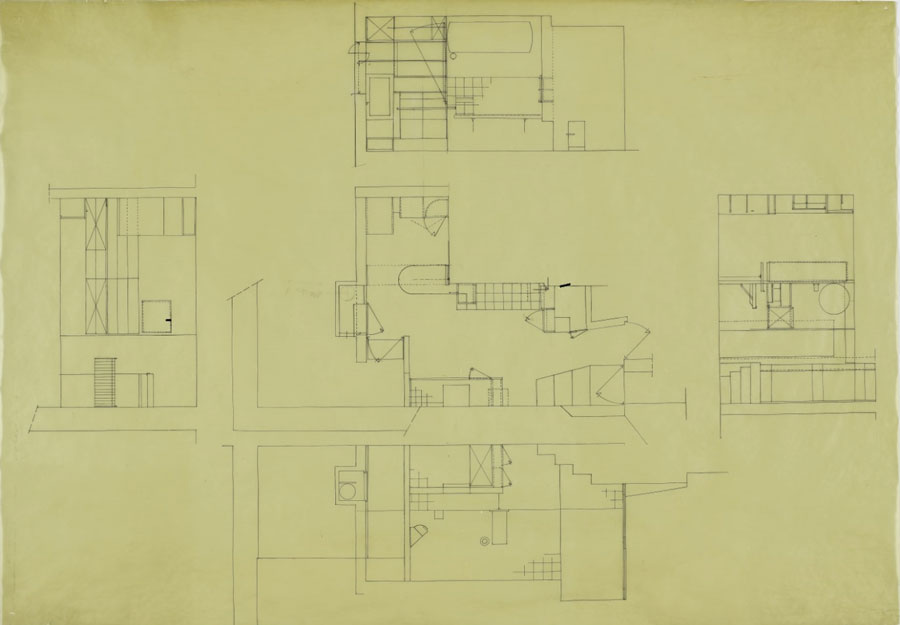
Eileen Gray (1878–1976)
Tempe a Pailla, kitchen plan and cross-section
India ink on paper
Centre Pompidou, Musée national d’art moderne, Paris, AM 1998-2-205
Third Floor, South Gallery
Tempe a Pailla, which Eileen Gray designed for herself, sits on a hilly mountain road, high above the port city of Menton in the south of France, where it overlooks the Mediterranean Sea. Here she pursued her architectural objectives in a relatively independent manner, completely separate from Jean Badovici and E 1027. Adhering to her principle of positioning living spaces in relation to the beautiful views and the daily path of the sun, Gray created a structure atop three existing cisterns. She overcame the house’s modest dimensions by combining and pairing functions within its primary spaces: entry foyer/dining room, living room/studio, bedroom/dressing area. She treated each room as a distinct spatial entity and manipulated each component to support a highly particularized and constructed way of life. Shifting the floor levels and ceiling heights, Gray took advantage of the sectional variation to provide ample storage compartments. She developed the interior using over-scaled cabinetry, echoing the dual purpose of each space in the fittings. Upon its completion, Gray named the house Tempe a Pailla after a local proverb, “With time and straw, the figs ripen” – a reference to the time it takes for one’s ideas to mature.
Tempe a Pailla, which Eileen Gray designed for herself, sits on a hilly mountain road, high above the port city of Menton in the south of France, where it overlooks the Mediterranean Sea. Here she pursued her architectural objectives in a relatively independent manner, completely separate from Jean Badovici and E 1027. Adhering to her principle of positioning living spaces in relation to the beautiful views and the daily path of the sun, Gray created a structure atop three existing cisterns. She overcame the house’s modest dimensions by combining and pairing functions within its primary spaces: entry foyer/dining room, living room/studio, bedroom/dressing area. She treated each room as a distinct spatial entity and manipulated each component to support a highly particularized and constructed way of life. Shifting the floor levels and ceiling heights, Gray took advantage of the sectional variation to provide ample storage compartments. She developed the interior using over-scaled cabinetry, echoing the dual purpose of each space in the fittings. Upon its completion, Gray named the house Tempe a Pailla after a local proverb, “With time and straw, the figs ripen” – a reference to the time it takes for one’s ideas to mature.





